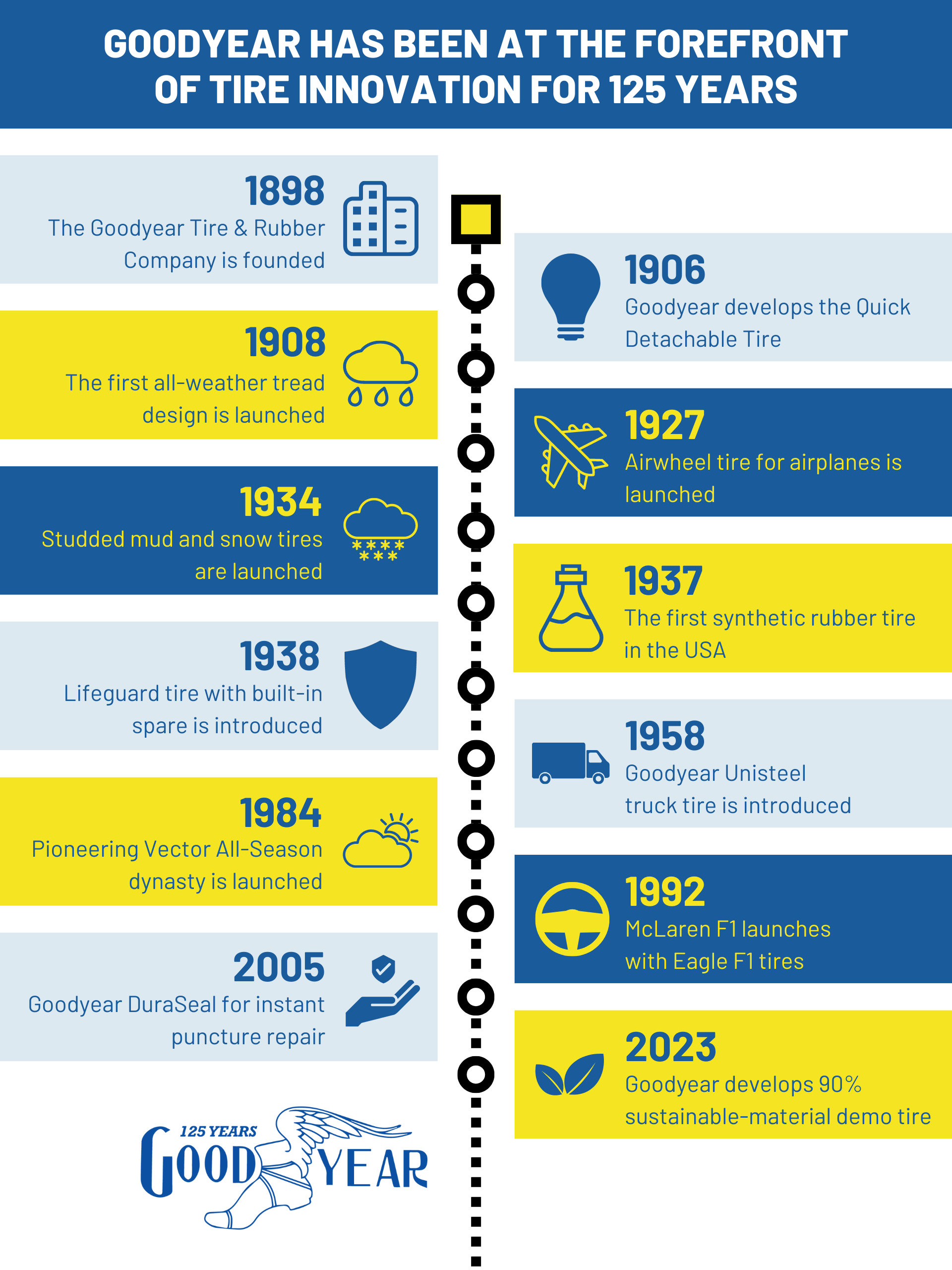From horse drawn to electrification: 125 years of Goodyear technology
A timeline of Goodyear Technology
1898: The Goodyear Tire and Rubber Company began producing horse-drawn carriage and bicycle tires on November 21, 1898, just a few weeks after the formation of the company on August 29. A year later, car tires were produced by Goodyear for the first time, beginning a century and a quarter of technology development that has transformed the way the world moves.
1903: Goodyear patented the first tubeless tire, but it was never commercially exploited until midway through the century.
1906: Goodyear developed the Quick Detachable Tire, a revolutionary design that made it easier for tires to be removed from the wheel while preventing cuts around the rim area. As cars began to replace the horse-drawn carriage, this was a major step forward in safety and convenience.
1908: Goodyear launched the first all-weather tread design. This diamond-studded pattern was used with only minor modifications for nearly 40 years.
1927: Goodyear launches Airwheel, a low-pressure tire, developed for aeroplanes, but later adapted for passenger car use. These ‘balloon tires’, combined with a small diameter rim, gave aeroplanes a much softer landing and brought ride comfort to the road industry, fitted to Fords and Chevrolets as original equipment within three years of launch.
1934: Goodyear launches studded mud and snow tires. Studded tires became the default solution for extreme winter driving, particularly on ice, for decades until the company developed the F32 All Winter Radial in the 1970s and later the UltraGrip Ice range for Nordic and Arctic markets in the late 20th century.
1937: Goodyear produces the first synthetic rubber tire in the USA. To reduce the impact on natural resources, and improve tire performance, the company was at the forefront of synthetic rubber production.
1938: Goodyear introduced the LifeGuard, a safety tire with a ‘built-in spare’. Effectively the forerunner of run-on-flat tires, it used separate air chambers near the tread and rim to ensure that, in the event of a puncture or blowout, the tire wouldn’t completely deflate. These safety tires, also known as Double Eagle, were standard equipment in NASCAR in that period.
1947: The Goodyear Super Cushion sets new standards for ride comfort. The tire combined the cushioning principle of a balloon tire, such as Airwheel, with the ability to run at much lower pressures. This made the tire run cooler, making it last longer. Within six months, Goodyear had supplied 3.5 million Super Cushion tires.
1955: Nearly half a century after the patent was granted, Goodyear tubeless tires became commonplace. The LifeGuard Blowout Shield allowed drivers to continue for up to 100 miles after a puncture.
1958: The Goodyear Unisteel truck tire is introduced, with radial wire and a three-ply breaker belt. The Unisteel range became renowned for durability and mileage for decades to come.
1962: Goodyear launched Super Single trailer tires for articulated trucks. A single wide tire to replace the dual-tire setup, it reduced the weight of trucks, allowing a greater carrying capacity.
1973: Goodyear Custom Steelguard excels in the American original equipment market, being the only steel-belted radial tire approved by all four U.S. carmakers.
1984: Goodyear introduced the all-season tire to the European market with the first iteration of the Goodyear Vector family. Since then, Goodyear has relentlessly pursued the development of a tire that performs all year long, whether in sun, rain or snow. This focus has paid dividends: Goodyear Vector tires have won more all-season tire tests than any other brand.
1992: Taking F1 to the road: The iconic McLaren F1 supercar featured specifically developed Goodyear Eagle F1 tires to manage the 620hp power output from its 6.1 litre V12 engine. The original McLaren press release highlighted the importance of Goodyear’s contribution: “Right from the McLaren F1’s initial design, the tire was considered as an intrinsic suspension element within the programme’s complex handling and comfort calculations. Weight, safety, noise and dynamic performance were all vital factors.”
1994: Goodyear Eagle F1 sets the standard for performance. The range was broadened to cover other supercar and sports car fitments with the distinctive Eagle F1 GS-D2 (Grand Sport - Directional) and later the GS-D3. Their striking directional patterns became a firm favourite with performance car drivers and tuners, combining dry weather handling prowess with stunning wet weather grip.
2001: The Goodyear GT3 tire, the world's first tire made with a compound derived from corn, is introduced at the Geneva Auto Show.
2005: Goodyear DuraSeal launched, giving instant puncture repair on the move for truck tires.
2006: Goodyear Fuel Max Technology is introduced on truck tires, saving fuel through an advanced construction and compound that reduces rolling resistance on long-haul truck operations.
2007: The Goodyear Eagle F1 range made its most dramatic design shift, moving from the trademark directional pattern to an all-new asymmetric construction to improve cornering performance and steering feel as performance cars began to gain weight, torque and power.
2018: Goodyear revealed EfficientGrip Performance, its first tire with Electric Drive Technology to cater to the increasing popularity of EVs.
2021: Goodyear SightLine launched. This global tire intelligence platform was designed to identify and address potential tire-related issues and relay information that only tires can feel.
2021: Goodyear launched NexTrek, a non-pneumatic (‘airless’) tire solution that began in-field testing on autonomous vehicles. Goodyear believes that airless tires may offer sustainable, maintenance-free and longer-lasting alternatives to conventional pneumatic tires.
2023: Goodyear reveals the 90% sustainable-material demonstration tire which includes 17 featured ingredients across 12 different components. The company continues to make progress toward its goal of introducing the first 100% sustainable-material tire in the industry by 2030.


